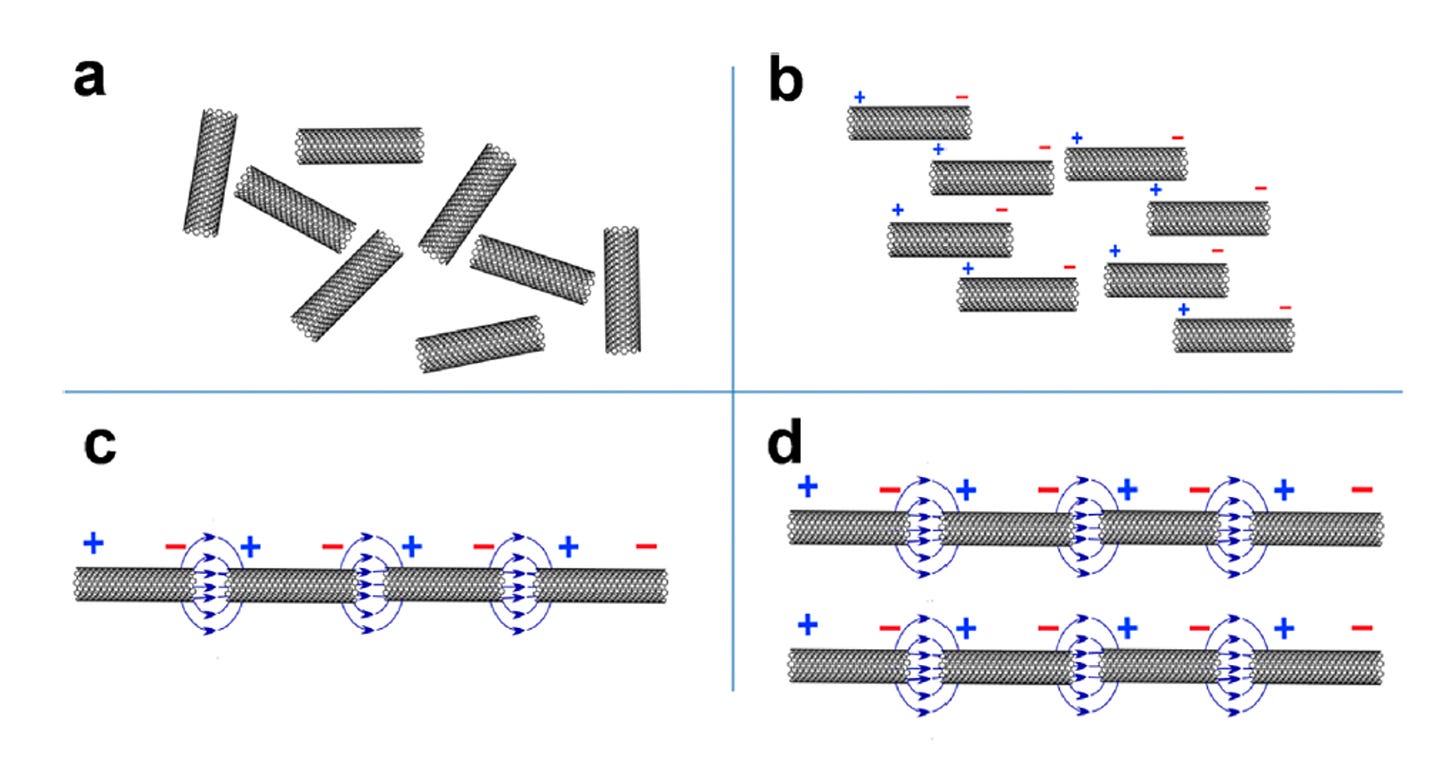How Come We Can See Nanotechnology Using Relatively Low Optical Magnification?
Because Nanomaterials can Assemble into Micro- and even Macro-scale objects. Case in Point: Teslaphoresis.
When people challenge you that when you present your optical microscopy images and videos, and talk about nanotechnology, don’t be intimidated. Here is a cohesive answer of just one example of how nanotech can be assembled in to microscale, and even macroscale objects, visible by naked eyes.
This work was pioneered and published at Rice University, in Houston, TX, and the main publication is dated 2016. But it conclusions are still as relevant today. (1)
It is noteworthy that the Tesla coil design utilized in the Rice University experiments exerted Teslophoretic (TEP) assembly effect up to several feet from the coil. Therefore, distance becomes more of an engineering problem, once it’s established that the effect is viable at a distance.
Below is a general schema of what’s happening to carbon nanotubes (CNT’s) whose size is typically 0.5 to 2 nm:
TESLAPHORETIC ASSEMBLY EXAMPLES:
When a carbon nanotube (CNT) powder is placed within a near-field of the Tesla coil (2Mhz, 30-50W), explosive self-assembly and growth of an individual CNT wire occurs within a few seconds.
Note: CNTs are incentive to 2Mhz frequency, however, not when it is applied as a beam exerted from a Tesla Coil!
When the CNTs are dispersed in solution, numerous nanotube wires begin to self-assemble rapidly and to combine into one or more larger parallel arrays.
Note: The assembly resulted in wires up to 15 cm in length - That’ a MACRO, VISIBLE scale!
Most Impressively, , near-field energy of the Tesla coil also wirelesslypowers and self-assembles nanotube circuits and remotely self-assembles parallel arrays of individual nanotubes from the bottom-up. See imagers below.
Noteworthy: The capability to simultaneously assemble and remotely power a wet circuit is a capability unique to the TEP method!
FROM NANO- TO MICRO- TO MACROSCALE:
Please pay attention to the size of the scale bar!
(a) Individualized, Pluronic wrapped CNTs self-assembledand organized into an array of visible nanotube wires on a glass microscope. Scale bar = 0.5 cm
(b) Visible microscope image (40x) of an array of CNT wires taken in the middle of the dried drop. Scale bar = 60 μm.
(c) Visible microscope image (20x) of the array with forks at the edge of the dried drop. Scale bar = 110 μm.
The findings above should take care of the argument we constantly hear from the critics of microscopy enthusiasts, when we are trying to bring attention of the public and allopathic physicians who have no clue whether nanotechnology plays any significant role in today’s health situation.
I will leave you with a video press release from the research group at Rice University.
Special thanks to Karen Kingston of The Kingston Report for guiding me in the right direction. Thank you for reading!
(1) DOI: 10.1021/acsnano.6b02313






Great article len, very relevant and very interesting. Thank you !
👍🏽👍🏿👍 Yes, thank you, Doc. As Karl C. has said—this is so very “relevant” for understanding how macro to nanotech self-assembly is possible. If we take into consideration AI quantum science & computing—that five years ago means “ancient” technologies—you can imagine how much more advanced this has become in just the past year. But that doesn’t mean old tech isn’t still being deployed. It most certainly is, as those who’ve been actually researching understands. I don’t trust anyone who claims to “know it all” or understands the whole truth, not when “compartmentalization” is so integrated within and between specialized departments evolving this technology in the dark for so many decades. Everyone should own a microscope and question everything.